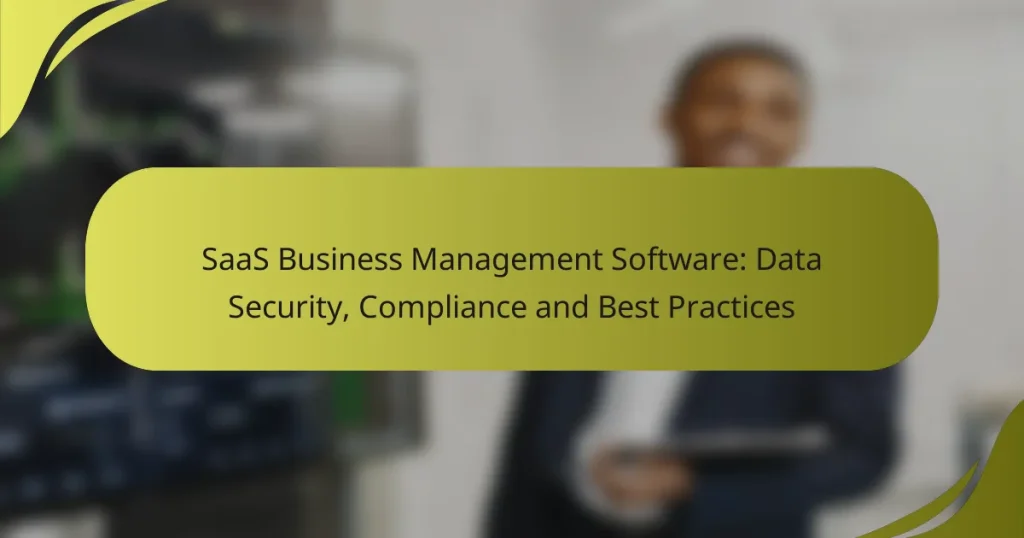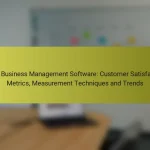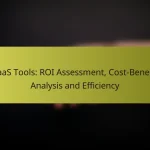In today’s digital landscape, selecting the right SaaS business management software is crucial for ensuring data security and regulatory compliance. Effective solutions incorporate robust encryption, user access controls, and features that align with legal standards, safeguarding sensitive information. By following best practices such as regular updates and multi-factor authentication, businesses can enhance their data protection strategies and maintain compliance with industry regulations.
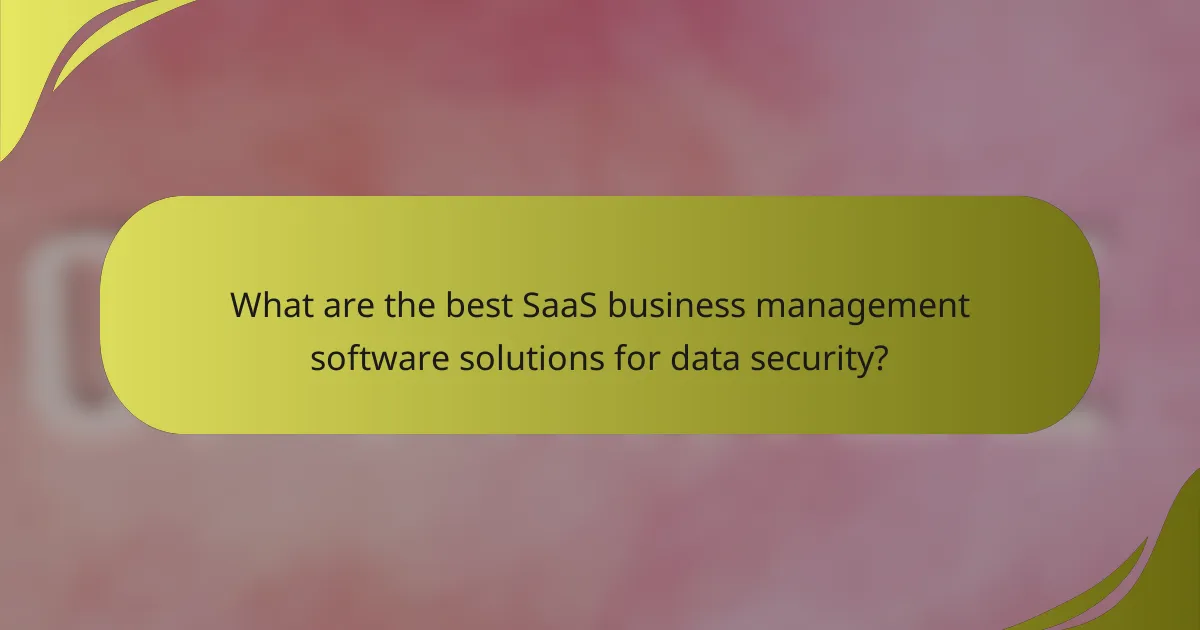
What are the best SaaS business management software solutions for data security?
The best SaaS business management software solutions for data security prioritize robust encryption, compliance with regulations, and user access controls. These features help protect sensitive data while ensuring that businesses meet necessary legal standards.
Microsoft Dynamics 365
Microsoft Dynamics 365 offers comprehensive data security features, including advanced encryption and multi-factor authentication. It complies with various regulations such as GDPR and HIPAA, making it suitable for businesses that handle sensitive information.
To enhance security, users can implement role-based access controls, ensuring that employees only access the data necessary for their roles. Regular security updates and a dedicated security team further bolster its reliability.
Zoho One
Zoho One provides a suite of applications with integrated security features like data encryption and secure APIs. It adheres to international standards such as ISO 27001, ensuring a high level of data protection.
Businesses can benefit from Zoho’s comprehensive audit logs and user management tools, which help track data access and modifications. Regular security assessments and compliance checks are recommended to maintain a secure environment.
NetSuite
NetSuite is designed with security in mind, featuring built-in data encryption and automated backups. It complies with various regulations, including PCI DSS, making it a solid choice for financial data management.
Users should take advantage of its customizable security settings, allowing for tailored access controls. Regular training on security best practices for employees can further enhance data protection efforts.
FreshBooks
FreshBooks emphasizes data security through SSL encryption and secure payment processing. It is particularly popular among small businesses and freelancers, providing a user-friendly interface while maintaining compliance with relevant regulations.
To maximize security, users should regularly update their passwords and enable two-factor authentication. Keeping software up to date is crucial to protect against vulnerabilities.
QuickBooks Online
QuickBooks Online offers robust security measures, including data encryption and secure cloud storage. It complies with standards such as GDPR, ensuring that user data is handled appropriately.
Businesses should utilize the platform’s user permissions settings to control access to sensitive financial information. Regularly reviewing security settings and conducting audits can help identify potential risks and enhance overall data security.

How do SaaS business management tools ensure compliance?
SaaS business management tools ensure compliance by integrating features that adhere to various regulatory standards and best practices. These tools often include built-in security measures, data handling protocols, and reporting capabilities that align with specific legal requirements.
GDPR compliance features
GDPR compliance features in SaaS tools focus on data protection and privacy for users in the European Union. Key elements include data encryption, user consent management, and the ability to delete personal data upon request.
To ensure compliance, businesses should verify that their SaaS provider offers features like data access logs and regular audits. Additionally, implementing a clear data processing agreement with the provider is crucial.
HIPAA compliance tools
HIPAA compliance tools are essential for SaaS solutions handling protected health information in the United States. These tools must include safeguards such as data encryption, secure user authentication, and audit trails to track data access and modifications.
Organizations should ensure their SaaS provider signs a Business Associate Agreement (BAA) to clarify responsibilities regarding data protection. Regular training for employees on HIPAA regulations is also recommended to minimize compliance risks.
ISO 27001 certifications
ISO 27001 certifications indicate that a SaaS provider adheres to international standards for information security management. This certification involves a comprehensive risk assessment and the implementation of security controls to protect sensitive data.
When selecting a SaaS provider, look for those with ISO 27001 certification as it demonstrates a commitment to maintaining high security standards. Regular reviews and updates of security policies are essential to sustain compliance over time.
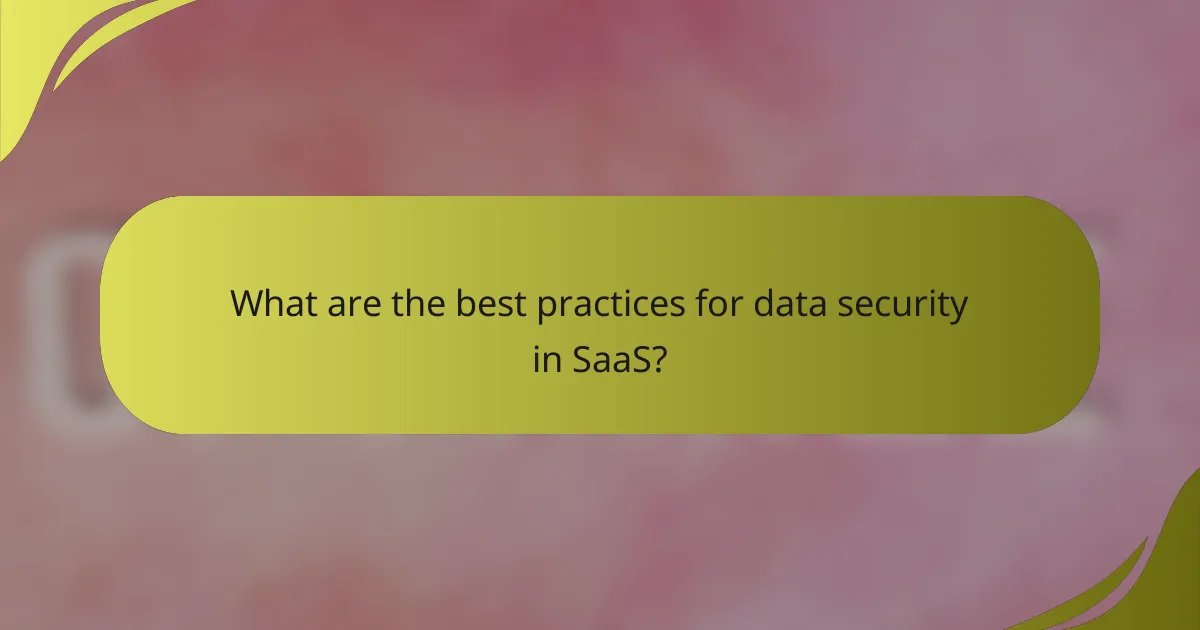
What are the best practices for data security in SaaS?
Best practices for data security in SaaS involve implementing robust measures to protect sensitive information from unauthorized access and breaches. Key strategies include regular software updates, data encryption methods, and multi-factor authentication.
Regular software updates
Regular software updates are crucial for maintaining data security in SaaS applications. These updates often include patches for vulnerabilities that could be exploited by attackers, ensuring that the software remains secure against emerging threats.
To effectively manage updates, establish a routine schedule for checking and applying updates. This could be monthly or quarterly, depending on the software’s criticality and the frequency of updates released by the vendor.
Additionally, consider using automated update systems where possible to minimize the risk of human error and ensure that updates are applied promptly.
Data encryption methods
Data encryption methods are essential for protecting sensitive information stored and transmitted by SaaS applications. Encryption converts data into a format that is unreadable without the appropriate decryption key, safeguarding it from unauthorized access.
Implement both at-rest and in-transit encryption to cover all bases. At-rest encryption secures data stored on servers, while in-transit encryption protects data as it moves between users and the cloud service. Common encryption standards include AES-256 for at-rest data and TLS for data in transit.
Regularly review and update encryption protocols to align with industry standards and best practices to ensure ongoing protection.
Multi-factor authentication
Multi-factor authentication (MFA) adds an extra layer of security by requiring users to provide two or more verification factors to gain access to their accounts. This significantly reduces the risk of unauthorized access, even if passwords are compromised.
Implement MFA by combining something the user knows (like a password) with something they have (like a smartphone app or hardware token) or something they are (like biometric data). This layered approach makes it much harder for attackers to gain access.
Encourage users to enable MFA on their accounts and provide clear instructions on how to set it up. Regularly assess the effectiveness of your MFA methods and update them as needed to counter evolving threats.
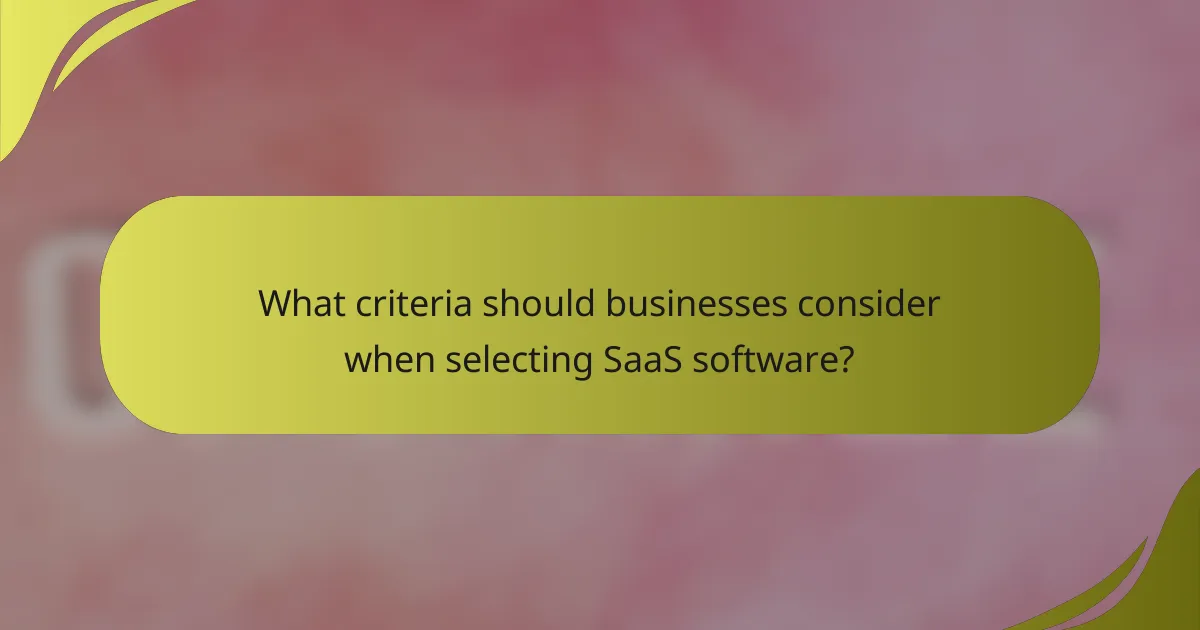
What criteria should businesses consider when selecting SaaS software?
Businesses should consider factors such as scalability, integration capabilities, and customer support when selecting SaaS software. These criteria ensure that the software can grow with the business, work seamlessly with existing systems, and provide reliable assistance when needed.
Scalability options
Scalability refers to the software’s ability to handle increased loads as a business grows. Look for solutions that offer flexible pricing tiers or usage-based models, allowing you to scale up or down based on your needs. This flexibility can prevent overspending on unused capacity or facing limitations during peak times.
Consider whether the software can accommodate additional users, features, or data without significant performance degradation. A good SaaS solution should maintain efficiency even as your business expands, ideally supporting thousands of users or large datasets without issues.
Integration capabilities
Integration capabilities determine how well the SaaS software can connect with other tools and systems your business uses. Look for solutions that offer APIs or pre-built integrations with popular applications, such as CRM, accounting, and project management tools. This connectivity can streamline workflows and enhance productivity.
Evaluate the ease of integration as well. A solution that requires extensive custom development may lead to higher costs and longer implementation times. Aim for software that allows for quick and straightforward integration, ideally with minimal disruption to your existing processes.
Customer support availability
Customer support availability is crucial for resolving issues quickly and minimizing downtime. Check the support options offered by the SaaS provider, such as live chat, email, or phone support, and their hours of operation. Ideally, support should be available during your business hours or even 24/7 for critical applications.
Additionally, consider the quality of support. Look for providers with a strong reputation for responsive and knowledgeable customer service. Reading reviews or requesting references can help gauge how effectively a provider handles support inquiries and technical issues.
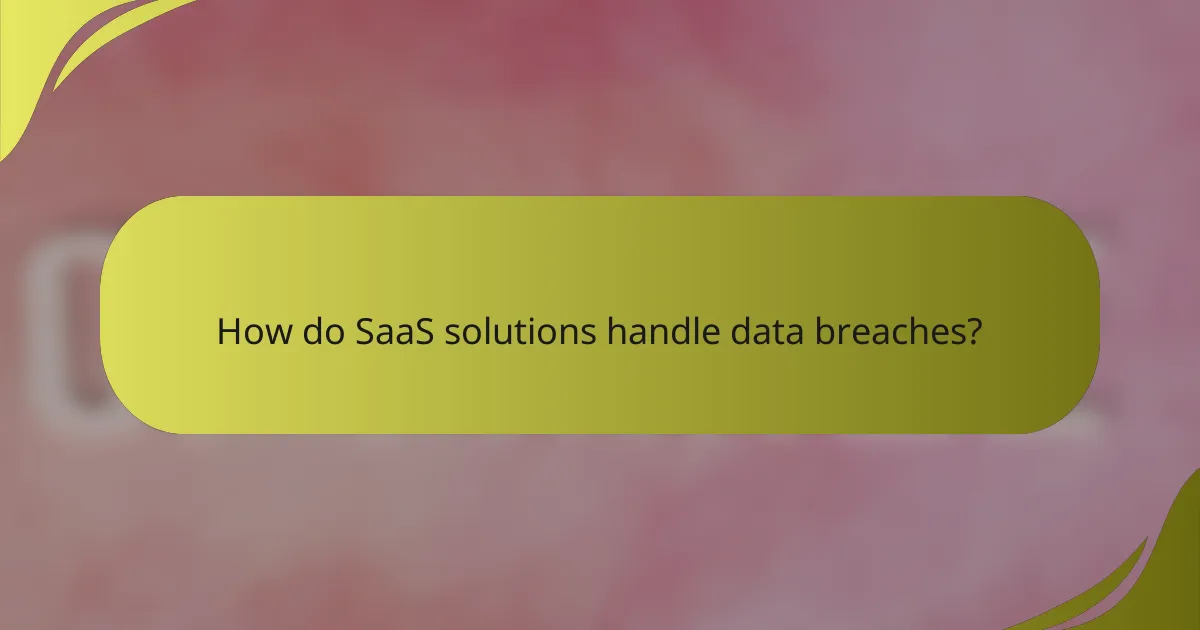
How do SaaS solutions handle data breaches?
SaaS solutions manage data breaches through a combination of proactive measures and reactive strategies. These include implementing security protocols, conducting regular audits, and having clear incident response plans in place to mitigate damage and restore services quickly.
Incident response plans
Incident response plans are essential for SaaS providers to effectively manage data breaches. These plans outline the steps to take when a breach occurs, including identifying the breach, containing it, and notifying affected parties. A well-defined plan typically includes roles and responsibilities, communication strategies, and timelines for each phase of the response.
For example, a typical incident response plan may involve a dedicated team that is trained to act swiftly. This team might conduct a post-incident review to analyze the breach and improve future responses. Regular drills can help ensure that all team members are familiar with their roles and can act efficiently during an actual incident.
Data recovery processes
Data recovery processes are critical for restoring services and minimizing data loss after a breach. These processes often involve backups, which should be regularly updated and stored securely. SaaS providers typically use a combination of on-site and cloud-based backups to ensure data can be recovered quickly and effectively.
In practice, a robust data recovery process might include automated backups that occur daily or weekly, depending on the business’s needs. Additionally, testing recovery procedures regularly is crucial to ensure that data can be restored within acceptable timeframes, often targeting recovery point objectives (RPO) and recovery time objectives (RTO) that align with industry standards.
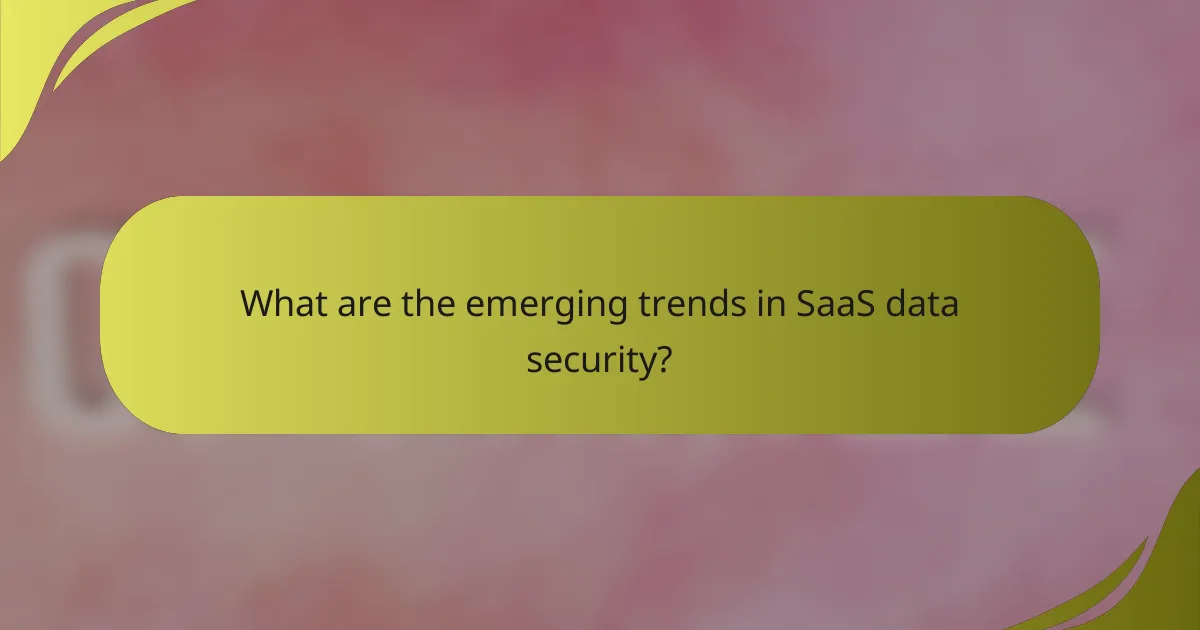
What are the emerging trends in SaaS data security?
Emerging trends in SaaS data security focus on advanced technologies and practices that enhance protection against cyber threats. Key developments include the integration of artificial intelligence, increased emphasis on compliance with regulations, and a shift towards zero-trust security models.
AI-driven security measures
AI-driven security measures utilize machine learning algorithms to detect and respond to threats in real-time. These systems analyze vast amounts of data to identify unusual patterns that may indicate a security breach, allowing for quicker mitigation efforts.
Organizations can implement AI solutions to automate routine security tasks, such as monitoring network traffic and analyzing user behavior. This not only reduces the workload on security teams but also improves response times, often addressing potential threats within seconds.
However, businesses should consider the balance between automation and human oversight. While AI can significantly enhance security, it is essential to maintain a skilled team to interpret AI findings and manage complex security incidents effectively.
